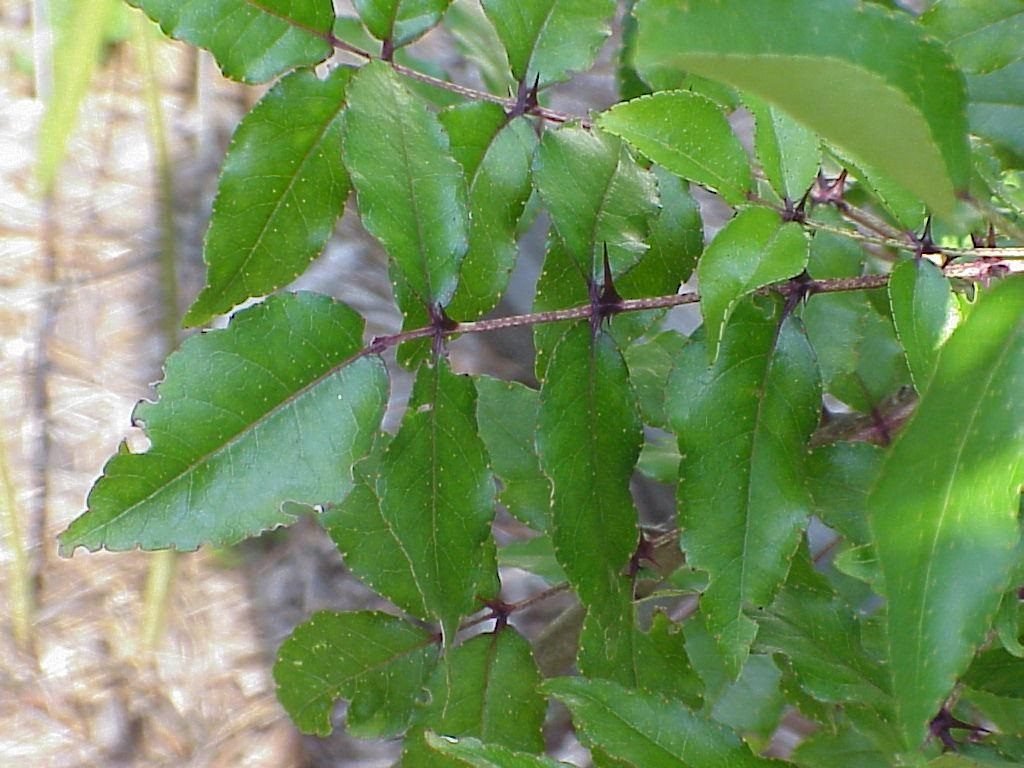Hercules Club

Hercules club’s other common names include prickly ash, southern prickly ash, toothache tree, sting tongue, and wild orange.
Zanthoxylum clava-herculis is a native tree in the Rutaceae, or citrus, family.
Hercules club is a deciduous tree that can attain a height of 35 feet. The national champion is found in Little Rock, Arkansas having a height of 38’, a spread of 59’ and a circumference of 7’6”. [1]
It is a craggy looking tree that grows in a variety of habitats from hammocks, wet woods, sand dunes, shell middens, sandy hammocks and fence rows.
The branches and trunk have large spines and with maturity the trunk’s thorns develop thick cushions of cork giving the tree a gnarled and spiky look.
The alternate and pinnately compound leaves grow to about a foot in length. The rachis (stem) of the leaves has sharp thorns. The leaflets can be from seven to nine in number and occasionally as many as twenty. The leaves are dark green above and glabrous (smooth) below. The margins are crenate (with rounded teeth).


The spines can leave a very sore spot if one is punctured by them. The site generally swells and is very sore. It generally leaves small spots where the puncture wound originally occurred. If pressure is applied a clear fluid exudes and some relief is achieved and within several days the wound will heal.
Hercules club blooms in the spring. The flowers are born in large clusters at the ends of the branches. The flowers are greenish yellow to greenish white in color. The flowers provide a nectar source for many pollinators.
Fertilized flowers produce round, green, fruits that once mature split open to partially expose an ovoid shaped, black fruit. The fruit is eaten by songbirds.
Hercules club is dioecious (male and female flowers are separate trees) so unless one has others nearby several specimens should be planted.
Zanthoxylum clava-herculis had, and has, many medicinal uses.
“ Indigenous people … used these two plants to treat bronchitis, tuberucolisis, for various infections, …. to treat hemorrhages intermittent fever, for kidney problems (including gonorrhea), flatulence, dropsy, rheumatism, to purify the blood, and as a general tonic ….. “Modern herbalists consider the bark and berries stimulants to the circulatory, digestive, and lymphatic systems.” [2]
“Bark tea … used by American Indians and herbalists for chronic rheumatism, dyspepsia, dysentery, kidney trouble, heart trouble, colds, coughs, lung ailments, and nervous debility. When chewed, bark induces copious salivation. Once popular to stimulate mucous surfaces, bile and pancreas activity. Bark chewed for toothaches. Berry tea used for sore throats, tonsillitis; also used as a diuretic.” [3]


It is a larval food plant for the giant swallowtail butterfly. The female butterfly lays her eggs on the new growth and the hatching caterpillars eat the leaves until they are large enough to pupate. The caterpillar generally moves away from the host tree to pupate.
Propagation is achieved through seeds, semi-hardwood cuttings, and transplanting small specimens.
The seeds need to be cold stratified for 2 to 3 months and then scarified, and soaked overnight before planting.
[1] Godfrey, Robert K.. Trees, Shrubs, and Woody Vines of Northern Florida and Adjacent Georgia and Alabama. Athens: University of Georgia. 1988. Print.
[2] Austin, Daniel F.. Florida Ethnobotany. Boca Raton, FL: CRC, 2004. Print.
[3] Foster, Steven, and James A. Duke. A Field Guide to Medicinal Plants: Eastern and Central North America. Boston: Houghton Mifflin, 1990. Print.
Next Article: Hollies Native to Central Florida
